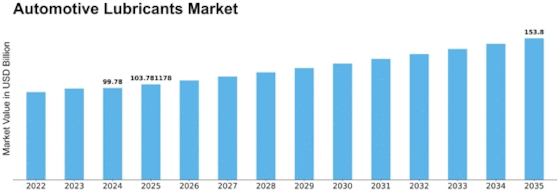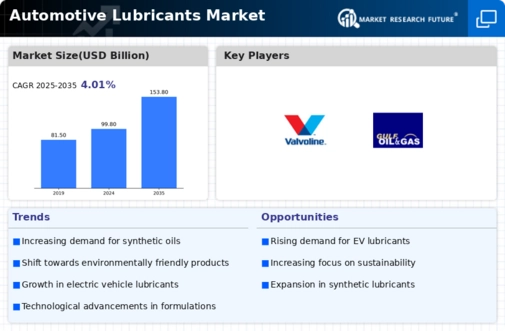Automotive Lubricants Size
Automotive Lubricants Market Growth Projections and Opportunities
The automotive lubricants market is heavily influenced by various market factors that shape its dynamics and growth trajectory. One crucial factor is the automotive industry's overall health and performance. As the automotive sector experiences fluctuations in production, sales, and innovation, it directly impacts the demand for lubricants. For instance, during periods of economic prosperity, increased vehicle sales translate to higher demand for lubricants due to more vehicles on the road requiring maintenance and servicing. Conversely, economic downturns can lead to reduced vehicle sales and aftermarket maintenance, affecting lubricant demand negatively.
Substances used for decreasing the friction between the movement of machines are called automotive lubricants. Reduction in friction will result in a reduction in heat generation from the machines. This will help the machine to work better and more efficiently. It is largely used in almost all types of vehicles such as heavy-weight commercial vehicles, light-weight commercial vehicles, passenger cars, three-wheelers, and two-wheelers. It helps in the smooth running of all these vehicles.
Technological advancements play a significant role in shaping the automotive lubricants market. Innovations in engine design, materials, and manufacturing processes directly influence lubricant requirements. For instance, the shift towards downsized turbocharged engines and electric vehicles (EVs) requires lubricants with specific characteristics such as improved thermal stability and compatibility with electric drivetrains. Manufacturers must continuously innovate to develop lubricants that meet the evolving needs of modern engines, ensuring optimal performance, fuel efficiency, and environmental sustainability.
Environmental regulations and sustainability concerns are increasingly influencing the automotive lubricants market. Stringent emissions standards and regulations aimed at reducing greenhouse gas emissions drive the demand for lubricants with lower viscosity and friction coefficients to improve fuel efficiency. Additionally, the push towards renewable and bio-based lubricants derived from sustainable sources aligns with global efforts to reduce carbon footprints and minimize environmental impact. Market players must adapt to these regulatory changes by developing eco-friendly lubricant solutions while ensuring compliance with evolving environmental standards.
Globalization and international trade significantly impact the automotive lubricants market. The expansion of automotive manufacturing and aftermarket services across regions creates opportunities and challenges for lubricant manufacturers and suppliers. Market players must navigate trade policies, tariffs, and regional regulations to effectively penetrate new markets and maintain competitiveness. Moreover, cultural and geographical differences in driving conditions and vehicle preferences influence lubricant demand patterns, requiring tailored product offerings and marketing strategies to succeed in diverse markets worldwide.
Consumer preferences and behavior also shape the automotive lubricants market landscape. Factors such as brand reputation, product performance, pricing, and convenience influence consumers' purchasing decisions when selecting lubricants for their vehicles. Brand loyalty and trust play a crucial role, with consumers often preferring established brands known for quality and reliability. Additionally, the rise of e-commerce platforms and online retailing has transformed the purchasing journey, providing consumers with greater accessibility and choice when buying lubricants.
Supply chain dynamics and raw material availability impact the automotive lubricants market's stability and pricing. Fluctuations in crude oil prices, the primary raw material for lubricant production, directly affect manufacturing costs and product pricing. Supply chain disruptions, geopolitical tensions, and natural disasters can also impact raw material availability and logistics, leading to supply shortages or price volatility. To mitigate these risks, lubricant manufacturers often employ strategic sourcing, inventory management, and supplier diversification strategies to ensure continuity of supply and minimize cost fluctuations.
Competitive rivalry within the automotive lubricants market intensifies as companies vie for market share and differentiation. Market players employ various strategies such as product innovation, strategic partnerships, mergers and acquisitions, and marketing campaigns to gain a competitive edge. Brand recognition, product quality, distribution networks, and customer service are key competitive factors that influence market positioning and profitability. Continuous investment in research and development is essential for staying ahead of competitors and meeting evolving customer needs in a rapidly changing market landscape.


















Leave a Comment